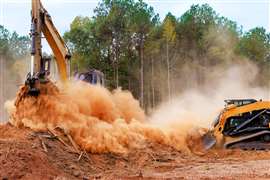Compact performance
24 April 2008
This Year Saw the First Phase of implementation of Europe's Stage IIIA engine laws, with the 130 to 560 kW power band being affected. The next two years will see smaller engine classes comply with the legislation, and this is where Perkins' new 400 Series units are aimed, covering power outputs from 8 to 49 kW.
The 400D Series spans a broader range of power outputs than the previous range through the addition of three new models, with the flagship being a new top of the range 404D-22TA that will generate 49,2 kW. The company's production schedule will see tests carried out on prototypes this month, with the 400 Series going into production at the start of next year. Perkins plans to have all models in the range available by the end of the third quarter of 2007.
The 400 Series is the result of a joint venture between Perkins, which owns 70% and Japanese manufacturer Ishikawajima Shibaura Machinery Ltd (ISM), which holds the remainder. The joint venture began engine production in 1996, and today engines are being produced in three plants, one each in the UK, Japan and the US.
Development
It is not just the emissions regulations that have been the drivers behind the development of the 400D. Noise is also a factor, with limits on permissible noise levels also tightening around the world, most notably in Europe. Continuous improvements in performance in terms of serviceability, cooling, electrics, lubrication, engine governing and the physical strength of the engines have also been sought.
Fourteen engines will make up the 400D range, from the 8 to 10 kW 402D-05 up to the largest, the 404D-22TA, with an output of 49,2 kW. The three new models are the 403D-15T, which plugs the gap that exists in the 400C Series in the 25 to 35 KW area. It will develop 30 kW and is a 1,5 litre turbocharged unit.
The second, the 403D-17, is intended to provide increased customer choice in the middle of the range. It is a 1,7 litre three cylinder naturally aspirated unit that develops 26 kW at 2600 rpm. It offers higher torque than the 403D-15 for where a naturally aspirated engine is required or where a turbocharged engine that which will come with a customer specified aftercooler but in the same package size as the 404D-T 2,2 turbo to provide increased power (49,2 kW at 2800 rpm).
The 400D engines will be quieter than their 400C counterparts, with a reduction in noise of up to 3 dB(A) sound power level at full load and no load. This has been achieved by reducing the fan speed as a result of improved cooling capability, a block design that offers better noise characteristics, strengthening of the timing case, and finally, low noise fan options will be available.
Users will see a number of performance gains with the new engines. Visible smoke emissions on start up will be less than with the 400Cs and the engines will cold start from -30°C. This has been achieved through the use of improved governor and fuel injection systems.
One key element of the 400D design process was more aimed at equipment manufacturers than end users. Packaging is becoming a major concern for OEMs as they struggle to fit increasingly complex engines into the modest engine bays available on most compact equipment.
Perkins therefore set itself four main goals where packaging was concerned - there was to be no increase in overall package size, all major hook up points should be unchanged, it should be possible to offer a lower position for the fan and, finally, it should be possible to offer reduced radiator sizing.
This has been achieved by careful internal engine design, with the coolant flow path in the cylinder head having been modified.




